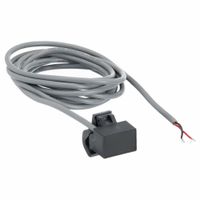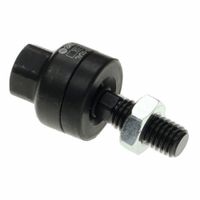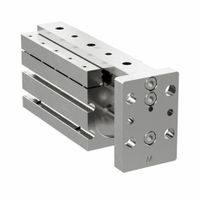Call +(254) 703 030 000 / 751 483 999 / 721 704 777
- Home
- Pneumatics
- Pneumatic Actuators
.....Read More
Frequently Asked Questions
What are pneumatic actuators and how do they work?
Pneumatic actuators are devices that convert energy from compressed air into mechanical motion. They are commonly used in industrial applications to automate processes, control valves, and drive machinery. The basic components of a pneumatic actuator include a cylinder, piston, and valves.
The operation begins with compressed air being supplied to the actuator. This air enters the cylinder, where it exerts pressure on the piston. Depending on the design, the piston can move linearly or rotate. In a linear actuator, the piston moves back and forth within the cylinder, creating linear motion. In a rotary actuator, the piston is connected to a mechanism that converts the linear motion into rotational motion.
The movement of the piston is controlled by valves that regulate the flow of air into and out of the cylinder. These valves can be manually operated or controlled by a computer system for precise automation. The speed and force of the actuator can be adjusted by varying the air pressure and flow rate.
Pneumatic actuators are favored for their simplicity, reliability, and ability to produce high force outputs. They are also safe to use in hazardous environments since they do not produce sparks and can operate in extreme temperatures. However, they require a continuous supply of compressed air and can be less energy-efficient compared to other types of actuators.
Overall, pneumatic actuators are essential components in many industrial systems, providing efficient and reliable motion control.
What are the different types of pneumatic actuators?
Pneumatic actuators are devices that convert compressed air into mechanical motion. They are widely used in various industrial applications due to their simplicity, reliability, and cost-effectiveness. The main types of pneumatic actuators include:
1. **Linear Actuators**: These actuators provide linear motion and are commonly used in applications requiring straight-line movement. The primary types are:
- **Pneumatic Cylinders**: These are the most common type, consisting of a piston inside a cylinder. They can be single-acting (air pressure moves the piston in one direction, with a spring or external force returning it) or double-acting (air pressure moves the piston in both directions).
- **Rodless Cylinders**: These have no piston rod extending outside the cylinder, allowing for a more compact design. They are ideal for applications with space constraints.
2. **Rotary Actuators**: These actuators provide rotational motion and are used in applications requiring angular movement. The main types are:
- **Vane Actuators**: These use a vane attached to a central shaft within a chamber. Air pressure causes the vane to rotate, providing angular motion.
- **Rack and Pinion Actuators**: These convert linear motion into rotational motion using a rack and pinion mechanism. They are known for their high torque output and precise control.
3. **Grippers**: These are specialized actuators used for grasping or holding objects. They can be parallel or angular, depending on the motion of the gripping jaws.
4. **Diaphragm Actuators**: These use a flexible diaphragm to convert air pressure into linear motion. They are often used in control valves and applications requiring precise positioning.
Each type of pneumatic actuator has its own advantages and is selected based on the specific requirements of the application, such as force, speed, stroke length, and environmental conditions.
How do pneumatic actuators compare to hydraulic and electric actuators?
Pneumatic actuators, hydraulic actuators, and electric actuators each have distinct characteristics that make them suitable for different applications.
Pneumatic actuators use compressed air to produce motion. They are known for their simplicity, reliability, and speed. Pneumatic systems are generally less expensive and easier to maintain than hydraulic systems. They are ideal for applications requiring rapid movement and are often used in industries like food processing and packaging. However, they are less precise than electric actuators and can be less efficient due to air compressibility, leading to energy losses.
Hydraulic actuators use pressurized fluid to generate motion. They are capable of producing high force and torque, making them suitable for heavy-duty applications such as construction equipment and industrial machinery. Hydraulic systems offer precise control and are highly reliable under extreme conditions. However, they are more complex, require regular maintenance, and can be prone to leaks, which may lead to environmental concerns.
Electric actuators convert electrical energy into mechanical motion. They offer high precision and control, making them ideal for applications requiring accurate positioning, such as robotics and automation. Electric actuators are energy-efficient, have a clean operation, and require less maintenance compared to hydraulic systems. However, they may not be suitable for high-force applications and can be more expensive initially.
In summary, pneumatic actuators are best for applications needing speed and simplicity, hydraulic actuators excel in high-force scenarios, and electric actuators are preferred for precision and control. The choice among them depends on specific application requirements, including force, speed, precision, cost, and environmental considerations.
What are the advantages of using pneumatic actuators?
Pneumatic actuators offer several advantages that make them a popular choice in various industrial applications:
1. **Simplicity and Reliability**: Pneumatic systems are relatively simple, consisting of a few basic components such as cylinders, valves, and compressors. This simplicity translates to high reliability and ease of maintenance, reducing downtime and operational costs.
2. **Speed and Responsiveness**: Pneumatic actuators can achieve rapid movement and quick response times, making them ideal for applications requiring fast actuation. The compressed air can be quickly vented and replenished, allowing for swift operation.
3. **Safety**: Pneumatic systems are inherently safe in hazardous environments. They do not produce sparks, making them suitable for explosive or flammable settings. Additionally, they can operate in extreme temperatures and harsh conditions without significant performance degradation.
4. **Cost-Effectiveness**: The initial cost of pneumatic components is generally lower compared to hydraulic or electric systems. The availability of compressed air in many industrial settings further reduces operational costs.
5. **Force and Power Density**: Pneumatic actuators can generate significant force relative to their size, providing a high power-to-weight ratio. This makes them suitable for applications where space is limited but substantial force is required.
6. **Cleanliness**: Pneumatic systems use air as the working medium, which is clean and does not contaminate the environment. This is particularly advantageous in industries like food processing and pharmaceuticals, where hygiene is critical.
7. **Flexibility and Modularity**: Pneumatic systems can be easily modified or expanded to accommodate changes in production processes. The modular nature allows for straightforward integration with existing systems.
8. **Energy Efficiency**: While not as efficient as electric systems, pneumatic actuators can be energy-efficient when properly designed and maintained, especially in applications with intermittent use.
These advantages make pneumatic actuators a versatile and effective solution for a wide range of industrial applications.
What applications are pneumatic actuators commonly used for?
Pneumatic actuators are widely used in various industries due to their reliability, simplicity, and cost-effectiveness. They are commonly employed in the following applications:
1. **Industrial Automation**: Pneumatic actuators are integral in manufacturing processes for tasks such as clamping, lifting, and positioning. They are used in assembly lines for automating repetitive tasks, enhancing efficiency and precision.
2. **Material Handling**: In logistics and warehousing, pneumatic actuators are used in conveyor systems, sorters, and pick-and-place machines to move and position goods efficiently.
3. **Valves and Flow Control**: They are extensively used to operate valves in pipelines for controlling the flow of liquids and gases. Industries such as oil and gas, water treatment, and chemical processing rely on pneumatic actuators for valve automation.
4. **Packaging Machinery**: Pneumatic actuators are used in packaging equipment for tasks like sealing, cutting, and filling. Their rapid response and reliability make them ideal for high-speed packaging lines.
5. **Robotics**: In robotics, pneumatic actuators provide movement and control for robotic arms and grippers, offering a cost-effective solution for tasks requiring less precision compared to electric actuators.
6. **Automotive Industry**: They are used in automotive manufacturing for tasks such as stamping, welding, and painting. Pneumatic systems are also used in vehicle suspension systems for load leveling.
7. **Aerospace**: Pneumatic actuators are used in aircraft systems for controlling flaps, landing gear, and other components due to their lightweight and reliable operation.
8. **HVAC Systems**: In heating, ventilation, and air conditioning systems, pneumatic actuators control dampers and valves to regulate airflow and temperature.
9. **Medical Equipment**: They are used in medical devices for applications like patient positioning and surgical tools, where precise and reliable movement is required.
These applications highlight the versatility and importance of pneumatic actuators across various sectors.
How do you maintain and troubleshoot pneumatic actuators?
To maintain and troubleshoot pneumatic actuators, follow these steps:
1. **Regular Inspection**: Conduct routine visual inspections for signs of wear, corrosion, or damage. Check for air leaks using soapy water to identify bubbles at connections.
2. **Lubrication**: Ensure moving parts are adequately lubricated to reduce friction and wear. Use manufacturer-recommended lubricants and follow specified intervals.
3. **Air Quality**: Maintain clean, dry, and oil-free air supply. Install filters, regulators, and lubricators (FRL units) to condition the air. Regularly check and replace filters.
4. **Tighten Connections**: Periodically check and tighten all pneumatic connections to prevent leaks and ensure efficient operation.
5. **Seal and Diaphragm Inspection**: Inspect seals and diaphragms for wear or damage. Replace them if necessary to prevent air leaks and ensure proper actuator function.
6. **Calibration**: Regularly calibrate the actuator to ensure it operates within specified parameters. Follow manufacturer guidelines for calibration procedures.
7. **Valve Positioning**: Check the actuator’s valve positioning for accuracy. Misalignment can cause operational issues and should be corrected promptly.
8. **Troubleshooting**:
- **Air Leaks**: Identify and fix leaks by tightening connections or replacing damaged components.
- **Inconsistent Movement**: Check for obstructions, misalignment, or inadequate air supply. Ensure the actuator is properly calibrated.
- **No Movement**: Verify air supply, check for blockages, and ensure the actuator is receiving the correct control signal.
- **Slow Operation**: Inspect for air supply issues, clogged filters, or mechanical binding.
9. **Documentation**: Keep detailed records of maintenance activities, inspections, and any issues encountered. This helps in tracking performance and identifying recurring problems.
10. **Training**: Ensure personnel are trained in proper maintenance and troubleshooting techniques to enhance efficiency and safety.
What factors should be considered when selecting a pneumatic actuator?
When selecting a pneumatic actuator, consider the following factors:
1. **Type of Motion**: Determine whether linear or rotary motion is required for the application.
2. **Force and Torque Requirements**: Calculate the necessary force or torque to move the load, considering factors like friction and load weight.
3. **Operating Pressure**: Ensure the actuator can operate efficiently at the available air pressure in the system.
4. **Speed of Operation**: Consider the required speed of actuation and ensure the actuator can meet these demands.
5. **Stroke Length**: For linear actuators, determine the required stroke length to ensure it meets the application's needs.
6. **Size and Weight**: Consider the physical dimensions and weight of the actuator, especially if space is limited or weight is a concern.
7. **Environmental Conditions**: Evaluate the operating environment, including temperature, humidity, and exposure to corrosive substances, to select materials and designs that can withstand these conditions.
8. **Control and Feedback**: Determine if position feedback or control is necessary for the application and select actuators with the appropriate sensors or control options.
9. **Durability and Maintenance**: Consider the expected lifespan and maintenance requirements, opting for robust designs with minimal maintenance needs.
10. **Cost**: Balance the cost of the actuator with the budget constraints while ensuring it meets all performance requirements.
11. **Compatibility**: Ensure the actuator is compatible with existing systems, including mounting options and connection interfaces.
12. **Safety and Compliance**: Verify that the actuator meets relevant safety standards and regulations for the application.
13. **Supplier Support**: Consider the availability of technical support and service from the manufacturer or supplier.
By evaluating these factors, you can select a pneumatic actuator that best fits the specific needs of your application.
How do pneumatic grippers function in production operations?
Pneumatic grippers function in production operations by utilizing compressed air to manipulate objects. They are a type of end-of-arm tooling used in automation systems, particularly in robotic applications, to handle, move, and position parts or products. The basic operation involves a pneumatic actuator, which converts the energy of compressed air into mechanical motion. This actuator is connected to fingers or jaws that open and close to grip or release objects.
The process begins with a control system that directs compressed air into the gripper's actuator. The air pressure causes the actuator to move, typically in a linear or rotary motion, depending on the design. This movement is transferred to the gripper's fingers, which are designed to conform to the shape of the object being handled. The fingers can be configured in various ways, such as parallel, angular, or custom shapes, to accommodate different object geometries.
Pneumatic grippers are favored in production operations for their simplicity, reliability, and speed. They are capable of rapid actuation, making them suitable for high-speed assembly lines. Additionally, they are relatively easy to maintain and can be integrated into existing systems with minimal modifications. The force exerted by the gripper can be adjusted by varying the air pressure, allowing for handling of delicate or heavy objects without causing damage.
In production environments, pneumatic grippers are used for tasks such as pick-and-place operations, assembly, packaging, and material handling. They are commonly found in industries like automotive, electronics, food and beverage, and pharmaceuticals, where they contribute to increased efficiency, precision, and safety in automated processes.
What role do pneumatic actuator controls play in system performance?
Pneumatic actuator controls are crucial in optimizing system performance across various industrial applications. They regulate the movement and positioning of actuators, which convert compressed air into mechanical motion. This control is essential for ensuring precision, efficiency, and reliability in automated systems.
Firstly, pneumatic actuator controls enhance precision by allowing for accurate positioning and movement of components. This is vital in applications requiring exact alignment, such as in manufacturing processes where even minor deviations can lead to defects.
Secondly, they contribute to system efficiency. By controlling the flow and pressure of air, these controls ensure that actuators operate at optimal levels, reducing energy consumption and wear on components. This efficiency translates to cost savings and prolonged equipment lifespan.
Reliability is another key aspect. Pneumatic actuator controls provide consistent performance under varying conditions, which is essential for maintaining system stability and minimizing downtime. They can be designed to handle different load capacities and environmental conditions, ensuring robust operation.
Moreover, these controls offer flexibility and adaptability. They can be easily integrated into existing systems and adjusted to meet specific operational requirements. This adaptability is crucial in dynamic industrial environments where processes and demands frequently change.
Safety is also enhanced through pneumatic actuator controls. They can be configured to include fail-safe mechanisms, ensuring that systems revert to a safe state in case of power loss or component failure, thus protecting both equipment and personnel.
In summary, pneumatic actuator controls play a pivotal role in system performance by enhancing precision, efficiency, reliability, flexibility, and safety. Their ability to regulate actuator operations effectively makes them indispensable in modern industrial automation.
How do position sensors enhance the functionality of pneumatic actuators?
Position sensors enhance the functionality of pneumatic actuators by providing precise feedback on the actuator's position, enabling improved control and efficiency. They allow for accurate monitoring of the actuator's movement, ensuring that it reaches the desired position with high precision. This feedback loop is crucial for applications requiring exact positioning, such as in automated manufacturing processes or robotics.
By integrating position sensors, pneumatic actuators can achieve better repeatability and reliability. The sensors detect the actuator's position in real-time, allowing for immediate adjustments to be made if deviations from the desired path occur. This capability reduces errors and enhances the quality of the end product.
Position sensors also contribute to energy efficiency. By providing accurate position data, they enable the control system to optimize the actuator's operation, minimizing air consumption and reducing wear and tear on the system. This leads to lower operational costs and extends the lifespan of the equipment.
Furthermore, position sensors facilitate advanced control strategies, such as closed-loop control systems, which are essential for complex tasks requiring dynamic adjustments. They enable the implementation of features like soft stops, variable speed control, and precise load handling, expanding the range of applications for pneumatic actuators.
In safety-critical applications, position sensors play a vital role by ensuring that actuators operate within safe limits. They can trigger alarms or shut down the system if the actuator moves beyond its intended range, preventing accidents and equipment damage.
Overall, position sensors significantly enhance the functionality of pneumatic actuators by providing the necessary data for precise control, improving efficiency, enabling advanced features, and ensuring safety.






